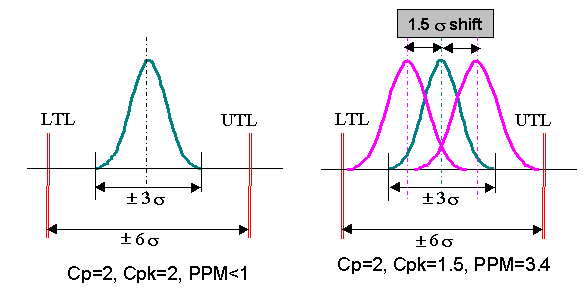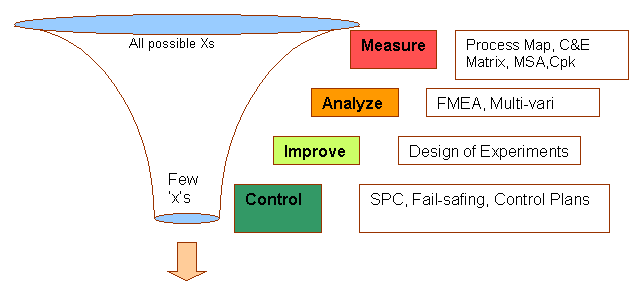|
Close your eyes and try to visualize that:
- Every train arrives on time and leaves on time!
- In a company employing 100 employees, no employee is late throughout the year!
- All the passengers get their luggage at the destination.
Are we crazy? No! These are examples to illustrate the meaning of Six Sigma quality level. Six Sigma is one idea that is adopted by organizations to become world class. It is aimed at reducing the defect levels in products and processes to a level of less than 3.4 defects per million opportunities.
Evolution of Six Sigma
The Six Sigma approach was first introduced and developed at Motorola in early 1990s. Later in the mid-nineties, it was adopted by General Electric and Allied Signal. According to Jack Welch CEO of GE "Six Sigma is the most challenging and potentially rewarding strategy GE have ever undertaken" GE listed tremendous benefits of the approach in their annual report in 1997. These benefits included:
- 10 fold increase in the life of CT scanner x-ray tubes at Medical Devices
- Improved yield resulting in increased capacity without additional investments at Superabrasives - their industrial diamond business
- 62% reduction in turnaround time at the repair shops of the railcar leasing business
- Addition of 300 million pounds of new capacity . This was equivalent to adding new plant!
In GE, Significant portions of the bonuses were linked to the introduction of Six Sigma. Six Sigma was originally centered around manufacturing improvements. The reason for this was knowledge of the statistical tools in the manufacturing functions and the ease with which we can quantify the benefits. However these improvements were not readily seen by the customers. The approach was therefore broadened to all business operations. The success of these companies with the Six Sigma approach caught the attention of Wall Street making it a popular strategy that is being adopted by many organizations worldwide. Indian organizations such as Wipro, Hero Motors, Godrej-GE have also adopted Six Sigma strategy to improve their businesses (Reference- Business Today, Sept 22, 1999).
What is Six Sigma?
Six Sigma is a highly disciplined approach used to reduce the process variations to the extent that the level of defects are drastically reduced to less than 3.4 per million process, product or service opportunities (DPMO). The approach relies heavily on advanced statistical tools. While these tools have been known earlier, these were primarily limited to the statisticians and quality professionals. Sigma (s) is Greek letter that is used to describe variability. In statistical quality control, this means "standard deviation".
Most of us may be familiar with the normal distribution and its properties. We are aware of the properties of Normal Distribution :
- 99.73% of the area lies within mean m ± 3s
- 95.46% of the area lies within mean m ± 2s
- 68.26% of the area lies within mean m ± s
When we proudly mention that our process capability Cp is 1.33, our process spread is ± 4 s. This would mean and estimated defect rate of 0.0063% or 63 defective parts per million (PPM). Moreover, when we deploy processes in production, the mean of the process can shift to the extent of approximately 1.5s. In such case the defect rate will increase to a much higher value. This would be about 6200 PPM! If the process capability is improved to a Cp of 2.0 the PPM level will come down to 0.002. With a shift of 1.5s, the Cpk will drop down to 1.5 and the number of parts defective will be about 3.4 PPM. A Cp of 2.0 corresponds to the process spread of ± 6 s. This is shown in the figures below.

Let us consider an example of an assembly with 30 parts and 5 steps. This means that there are 30x5 or 150 opportunities for a defect to occur. If we find that there are 100 defects in every 100 assemblies. This means one defect per assembly or 1 million defects in one million assemblies. This can be converted to 1000000 x (1/150) or 6666 defects per million opportunities (DPMO). This approximately corresponds to a sigma level of 3.97. The sigma quality level can be approximately determined using the equation (Schmidt and Launsby 1997):

Refer to the following table for relation between sigma quality level and PPM. The PPM values are calculated considering a shift of 1.5 s.
| s |
PPM |
| 2 |
308,537 |
| 3 |
66,807 |
| 4 |
6,201 |
| 5 |
233 |
| 6 |
3.4 |
Another concept that is used as a metric in Six Sigma is Rolled Throughput Yield (RTY). Let us assume that a part goes through ten operations. At each stage 99% parts are good and 1% are reject. It is not very difficult to calculate that we get good 90.43 % parts at the end of the tenth stage. This means if we start with a batch of 1000 parts, we get 904 good parts and scrap or rework 96 part! The RTY of the process is 90.43%.
While we are talking about the statistical basis of the PPM levels, Six Sigma is not only about statistical methods. The backbone of a successful Six Sigma approach is strong commitment of top management. This is like any other successful programs. Moreover, all improvements planned through Six Sigma projects must have a direct benefit that can be measured in terms of improvement in the bottom-line.
The Six Sigma Methodology
The projects having large impact of customer satisfaction and significant impact on bottom-line are selected. Top management of the organization has very important role during selection of projects and leaders. The projects are clearly defined in terms of expected key deliverables. These are typically in terms of DPMO levels or sigma quality levels, RTY, Quality Cost etc. In the overall approach, the actual problem is converted in to a statistical problem. This is done by mapping the process, defining key process input variables (KPIVs or 'x's) and key process output variables (KPOVs or 'y 's). The power of statistical tools is used to determine a statistical solution. This is then converted in to a practical solution.

Six Sigma projects go through four phases:
The number of 'x' s go on getting eliminated using various statistical and other tools. This is as if the variation is getting reduced as it passes through a funnel of the Six Sigma methodology. This is sometimes called the breakthrough strategy.

The cause and effects relationship between the KPOVs ('y's) and KPIVs ('x's) gets clearer as the project goes through the four phases. Control plans are documented before the closure of the project so that gains are sustained. The project leaders must demonstrate that the key deliverables of the project are achieved and demonstrated.
Strategies for Six Sigma introduction
There are three different strategies adopted by different organizations:
- The Six Sigma organization
- The Six Sigma engineering organization
- Strategic selection of Six Sigma projects
1. The Six Sigma organization
In this strategy, the whole organization is trained on Six Sigma philosophy and methods. The training is of varying depth for various levels. Six Sigma serves as motivational device and also as a metric. Goals are defined in terms of sigma. While the organization can have a common language of Six Sigma, large resources are required for training. All improvement ideas are likely to be credited to Six Sigma regardless of the approach actually used!
2. The Six Sigma Engineering Organization:
Here, the attempt is to develop skills in the Engineering functions. The project objectives are usually based on new products, product changes or problem solving. One of the advantages is the relatively higher level of educational and technical background of the individuals that enables them to learn at a faster pace. On the other hand, individuals from other functions do not appreciate the efforts in absence of the awareness of the techniques.
3. Strategic selection of Six Sigma projects
The senior management sometimes feels that the current quality processes are generally working well to achieve the overall strategic plan. Hence Six Sigma tools and concepts are used to enhance the existing quality processes and supplement the skills of the key people thereby making breakthrough improvements. Six Sigma projects are identified considering the:
- Strategic direction of the company
- Impact on the bottom-line
- Impact on customer satisfaction
The projects having large impact requires project leaders with high degree of competence. Full time project leaders (sometimes called the Black Belts) are selected to execute the project. Selection of candidates is critical for the success. The project leaders go through in-depth training of Six Sigma approach and tools and work full time on the project. The project is expected to be completed in about six months. Typical savings expected from a black belt project may be of the order of Rs. 100,00000. Projects of lesser complexity may not require full time resource. Project leaders of such projects are chosen from the same functional area. These are sometimes called Green Belts. They also go through training in the Six Sigma concepts and tools. Training duration is usually less than that for black belts.
This approach requires lesser resources for training that can be customized. The organizations adapting this approach must allocate the best people as project leaders. Some of the potential failure modes of this approach are:
- Trained engineers tend to get isolated
- Communication barrier due to lack of common language
- Failure to develop management understanding
Criticism on Six Sigma
There has been a lot of criticism on Six Sigma. Many feel that the tools used in the approach have been existing and in reality there is nothing new in sigma In short, Six Sigma is old wine in new bottle. The criticism is true in a way. However, others feel that while the tools existed earlier, quantification of the metrics and direct relation to the bottom-line makes it somewhat different.
Another major criticism is about the price tag attached to the Six Sigma training. Typical price tag of a four week black belt course is $ 25000! This is prohibitive for most of the small and medium scale organization. However, training costs may come down in the near future. Another criticism on Six Sigma is it results in to short term improvement projects. This is countered by its proponents that although one project is of six months duration, the black belts take up next project also train others in Six Sigma methodology. As more black belts are trained and large number of projects are completed; the organization achieves long term benefits.
Concluding Remarks
Six Sigma is powerful approach to achieve breakthrough improvements in manufacturing, engineering and business processes. The approach relies heavily on advanced statistical methods that complement the process and product knowledge to reduce variation in processes.
It is new way of doing business that would eliminate the existing defects efficiently and would prevent defects from occurring. Different strategies are used by organizations to introduce and deploy Six Sigma approach. Each of these strategies has advantages and potential failure modes that must be addressed and avoided.
References:
- Forrest W Breyfogle III, Implementing Six Sigma- Smarter Solutions Using Statistical Methods published by John Wiley and Sons, Inc.
- Drug Sanders and Cheryl Hild, A Discussion of Strategies for Six Sigma implementation, Quality Engineering, Vol. 12, Number 3, 2000.
- Gerald J.Hahn and Necip Doganaksoy, Roger Hoerl, The Evolution of Six Sigma, Quality Engineering, Vol. 12, Number 3, 2000.
Author:
Hemant Urdhwareshe
52, Ex Servicemen's Colony,
Pune 411038.INDIA.
Published: September 2000
|
Mr. Hemant Urdhwareshe, C.Q.Mgr., C.Q.E. (ASQ) is General Manager, Supplier Quality Assurance and Supplier Quality Improvement at Cummins India Ltd.
He can be contacted through us at info@symphonytech.com
|
|

 Top
Top